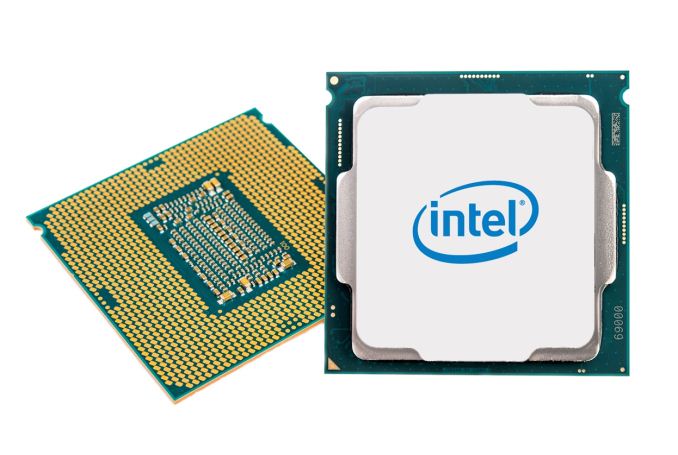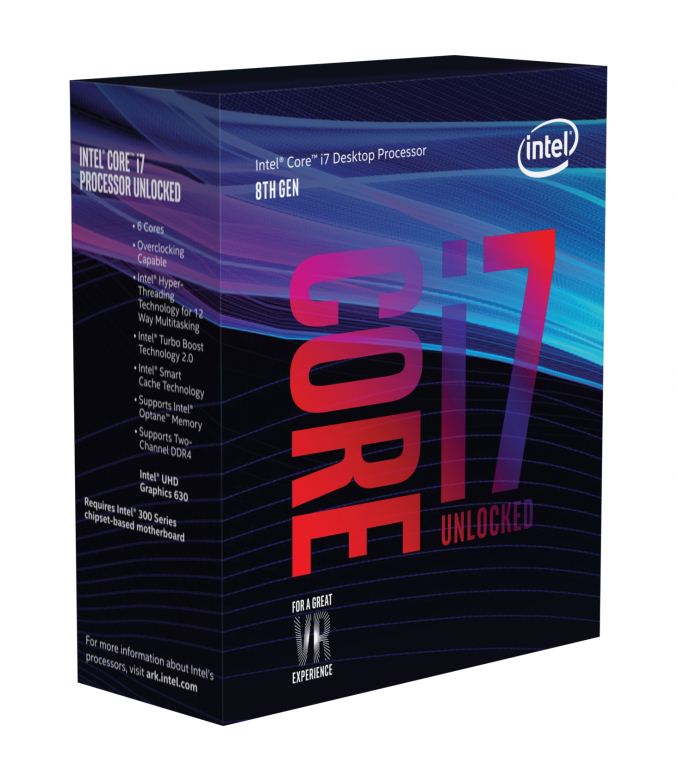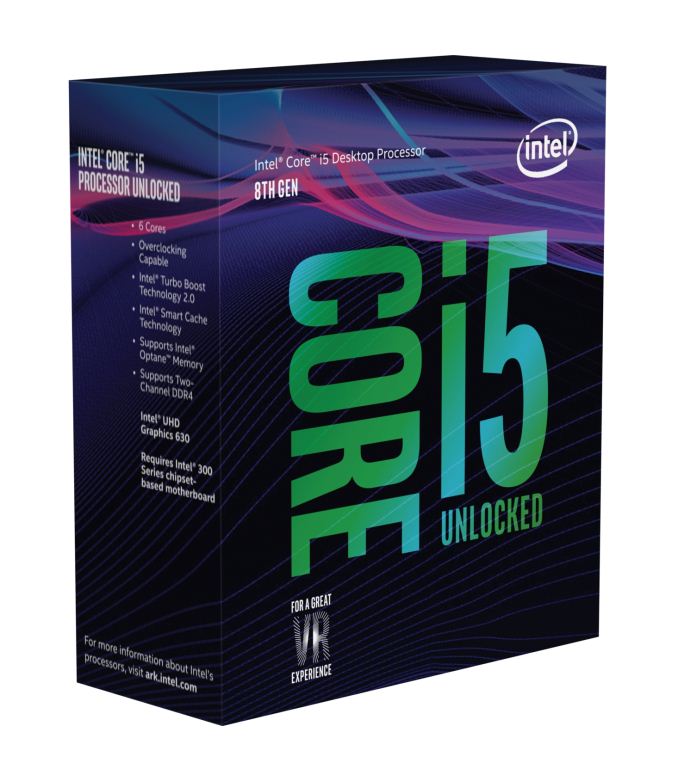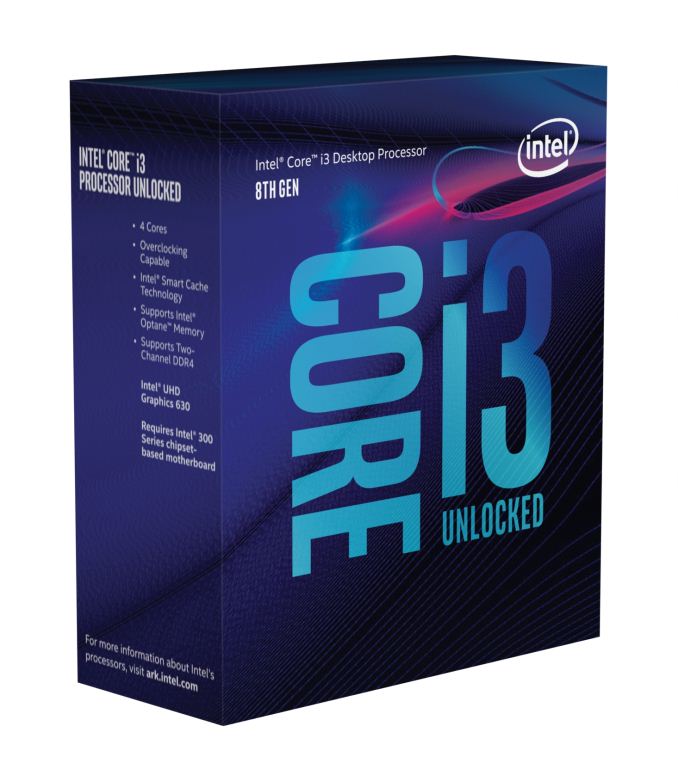The AnandTech Coffee Lake Review: Initial Numbers on the Core i7-8700K and Core i5-8400
by Ian Cutress on October 5, 2017 9:00 AM EST- Posted in
- CPUs
- Intel
- Core i5
- Core i7
- Core i3
- 14nm
- Coffee Lake
- 14++
- Hex-Core
- Hyperthreading

It has been ten years since Intel introduced quad-core processors into its mainstream product range. It was expected that six-core parts would hit the segment a few years after, however due to process improvements, microarchitecture gains, cost, and a lack of competition, the top-end mainstream processor is still a quad-core a decade later. That changes today.
Launching today are Intel's new 8th Generation Coffee Lake CPUs, with the Core i5 and Core i7 parts having six distinct physical cores. In this review we're covering the top SKU, the Core i7-8700K, along with looking at numbers from the Core i5-8400.
Coffee Lake Hits Primetime
There are a number of interesting elements to this launch to be excited about, and a number of factors that raise even further questions, which we will go in to.
To start, the processor stack that Intel is making available today consists of six desktop processors that all fall under the ‘8th Generation’ nomenclature, and are built under the codename ‘Coffee Lake’ to designate the microarchitecture and manufacturing process combination.
All these new processors are desktop parts, meaning they are socketed processors for use in appropriate motherboards featuring the Z370 chipset. Technically these processors use the LGA1151 socket, which is also used by the 6th Generation and 7th Generation processors with the Z170 and Z270 chipsets. However due to differences in the pin-layout of these two sets of processors, 8th Gen will only work in Z370 boards and there is no level of cross compatibility. We will discuss this later.
| Intel 8th Generation 'Coffee Lake' Desktop Processors | ||||||
| i7-8700K | i7-8700 | i5-8600K | i5-8400 | i3-8350K | i3-8100 | |
| Cores | 6C / 12T | 6C / 6T | 4C / 4T | |||
| Base Frequency | 3.7 GHz | 3.2 GHz | 3.6 GHz | 2.8 GHz | 4.0 GHz | 3.6 GHz |
| Turbo Boost 2.0 | 4.7 GHz | 4.6 GHz | 4.3 GHz | 4.0 GHz | - | - |
| L3 Cache | 12 MB | 9 MB | 8 MB | 6 MB | ||
| DRAM Support | DDR4-2666 | DDR4-2400 | ||||
| Integrated Graphics | GT2: 24 EUs | GT2: 23 EUs | ||||
| IGP Base Freq | 350 MHz | 350 MHz | ||||
| IGP Turbo | 1.20 GHz | 1.15 GHz | 1.05 GHz | 1.15 GHz | 1.10 GHz | |
| PCIe Lanes (CPU) | 16 | 16 | ||||
| PCIe Lanes (Z370) | < 24 | < 24 | ||||
| TDP | 95 W | 65 W | 95 W | 65 W | 91 W | 65 W |
| Price (tray) | $359 | $303 | $257 | $182 | $168 | $117 |
| Price (Newegg) Sale until 10/12 |
$380 | $315 | $260 | $190 | $180 | $120 |
| Price (Amazon) | $N/A | $N/A | $N/A | $N/A | $N/A | $N/A |
At the top of the stack are two Core i7 Coffee Lake processors. In previous generations ‘Core i7’ meant that we were discussing quad-core parts with hyperthreading, but for this generation it moves up to a six-core part with hyperthreading. The Core i7-8700K starts at a 3.7 GHz base frequency and is designed to turbo to 4.7 GHz in single threaded workloads, with a thermal design power (TDP) of 95W. The K designation means this processor is unlocked and can be overclocked by adjusting the frequency multiplier, subject to appropriate cooling, applied voltage, and the quality of the chip (Intel only guarantees 4.7 GHz). The Core i7-8700 is the non-K variant, with lower clocks (3.2 GHz base, 4.6 GHz turbo) and a lower TDP (65W). Both of these processors use 256 KB of L2 cache per core and 2 MB of L3 cache per core.
| Kaby Lake i7-K vs Coffee Lake i7-K | ||
| i7-7700K | i7-8700K | |
| 4C / 8T | Cores | 6C / 12T |
| 4.2 GHz | Base Frequency | 3.7 GHz |
| 4.5 GHz | Turbo Boost 2.0 | 4.7 GHz |
| 8 MB | L3 Cache | 12 MB |
| DDR4-2400 | DRAM Support | DDR4-2666 |
| GT2: 24 EUs | Integrated Graphics | GT2: 24 EUs |
| 350 MHz | IGP Base Freq | 350 MHz |
| 1.15 GHz | IGP Turbo | 1.20 GHz |
| 16 | PCIe Lanes (CPU) | 16 |
| < 24 | PCIe Lanes (Chipset) | < 24 |
| 95W | TDP | 95 W |
| $339 | Price (tray) | $359 |
| $340 | Price (Newegg) | $380 |
| $351 | Price (Amazon) | $N/A |
When compared to the previous generation, the Core i7-8700K starts at a higher price, but for that price comes more cores and a higher turbo frequency. The Core i7-8700K is a good example of how adding cores works: in order to keep the same power consumption, the overall base frequency has to be lowered to match the presence of extra cores. However, in order to keep the responsiveness higher than the previous generation, the single thread performance is often pushed to a higher multiplier. In almost all situations this counts as a win-win, and makes pushing for the 6-core part, on paper at least, a no-brainer.
| Kaby Lake i5-7400 vs Coffee Lake i5-8400 | ||
| i5-7400 | i5-8400 | |
| 4C / 4T | Cores | 6C / 6T |
| 3.0 GHz | Base Frequency | 2.8 GHz |
| 3.5 GHz | Turbo Boost 2.0 | 4.0 GHz |
| 6 MB | L3 Cache | 9 MB |
| DDR4-2400 | DRAM Support | DDR4-2666 |
| GT2 | Integrated Graphics | GT2: 23 EUs |
| 350 MHz | IGP Base Freq | 350 MHz |
| 1.00 GHz | IGP Turbo | 1.05 GHz |
| 16 | PCIe Lanes (CPU) | 16 |
| < 24 | PCIe Lanes (Chipset) | < 24 |
| 65 W | TDP | 65 W |
| $182 | Price (tray) | $182 |
| $190 | Price (Newegg) | $190 |
| $185 | Price (Amazon) | $N/A |
In the middle of the stack are the Core i5 processors, with the new generation matching the ‘same configuration without hyperthreading’ philosophy that followed in the previous generation. The two Core i5 parts operate at lower clockspeeds compared to the Core i7, and perhaps more so than we are previously used to, especially with the Core i5-8400 having a base frequency of 2.8 GHz. Intel sampled us the Core i5-8400 for our review, because it hits an important metric: six cores for under $200. Comparing cache sizes to the Core i7, the new parts have the same L2 configuration at 256 KB per core, but have a reduced L3 at 1.5 MB per core as part of the product segmentation.
| Kaby Lake i5-7400 vs Coffee Lake i3-8100 | ||
| i5-7400 | i3-8100 | |
| 4C / 4T | Cores | 4C / 4T |
| 3.0 GHz | Base Frequency | 3.6 GHz |
| 3.5 GHz | Turbo Boost 2.0 | - |
| 6 MB | L3 Cache | 6 MB |
| DDR4-2400 | DRAM Support | DDR4-2400 |
| GT2 | Integrated Graphics | GT2: 23 EUs |
| 350 MHz | IGP Base Freq | 350 MHz |
| 1.00 GHz | IGP Turbo | 1.10 GHz |
| 16 | PCIe Lanes (CPU) | 16 |
| < 24 | PCIe Lanes (Chipset) | < 24 |
| 65 W | TDP | 65 W |
| $182 | Price (tray) | $117 |
| $190 | Price (Newegg) | $120 |
| $185 | Price (Amazon) | $N/A |
It is interesting to note that in the last generation, Intel had processors with two cores and two threads (2C/2T), two cores with hyperthreading (2C/4T), quad cores with four threads (4C/4T) and quad cores with hyperthreading (4C/8T). This layout had staggered, regular steps. With the move to 6C/12T on the high-end Core i7, and 6C/6T on the mid-range Core i5, Intel completely skips the 4C/8T parts and moves straight to 4C/4T on the Core i3. This is likely because a 4C/8T processor might overtake a 6C/6T part in some multi-threaded tests (it would also explain why moving from a previous 4C/8T Core i7 processor to a 6C/6T Core i5 8th generation is not always an increase in performance).
However at the bottom of the stack are the 4C/4T Core i3 processors, where Intel is pushing out an overclockable Core i3 processor again. This is a little bit of a surprise: in our testing of the previous generation overclockable Core i3, the fact that it was dual core was a setback in a lot of testing. With the Core i3-K now being quad-core, and overclocking it to try and beat a six-core chip for less money, for certain things like gaming we might see less of a difference between the two. Nonetheless, the Core i3s do retain the policy of no Turbo modes on these parts. Another interesting point is the cache: the i3-8350K has 2 MB of L3 cache per core, whereas the i3-8100 only has 1.5 MB of L3 cache per core.
One of our key items to watch in this segment from the initial announcement is that i3-8100. Here is a quad-core processor for only $117. I suspect that this will hit most of the mainstream computing requirements that the previous generation Core i5 (at $182) used to cater for. On paper at least, it seems Intel might have an interesting task trying to explain why more users are opting for a Core i3 this time around.
Turbo Modes
One of the interesting things to come out of our briefings with Intel was the fact that Intel made a very clear change in policy when it comes to press disclosure. When the question was asked about per-core turbo values for each of the CPUs, Intel made a clear statement first, then a secondary one when quizzed further:
“Intel will no longer provide this information”
"We are only including processor frequencies for base and single-core Turbo in our materials going forward - the reasoning is that turbo frequencies are opportunistic given their dependency on system configuration and workloads"
This change in policy is somewhat concerning and completely unnecessary. The information itself could be easily obtained by actually having the processors and probing the required P-states (assuming the motherboard manufacturer does not play silly tricks), so this comes across as Intel withholding information for arbitrary reasons.
Nonetheless, we were able to obtain the per-core turbo ratios for each of the new processors for our motherboard. Given Intel's statement above, it seems to suggest that each motherboard might have different values for these, with no Intel guidelines given.
For the most part, there is nothing out of the ordinary here. Intel uses the base frequency as a guaranteed base under abnormal environmental circumstances and heavy code (AVX2), although in most circumstances even the all-core turbo ratio will be higher than the base frequency.
The odd-one-out is actually the Core i5-8400. It is being shipped with a low base frequency, at 2.8 GHz, but the all-core turbo ratio is 3.8 GHz. Shipping with such a low base frequency is perhaps masking the performance of this part: it should be, on paper at least, only a whisker or two behind the Core i5-8600K.
It is noticeable that the two Core i7 parts both have an all-core turbo of 4.3 GHz, which is only ever matched by the single threaded turbo of the Core i5-8600K. Not only is moving up from the Core i5 to the Core i7 doubling the threads, but the frequency gain is another addition in performance. The Core i5-8600K has a tray price of $257, while the Core i7-8700 is at $303. Overclocking is lost but the threads are doubled, the available turbo frequencies are improved, the cache goes up, and the TDP goes down.
CPU A, $250. CPU B, $300.
— Ian Cutress (@IanCutress) October 5, 2017
CPU A has overclocking.
CPU B has double threads, +20% frequency at stock, +33% L3 cache, 1/3 less TDP, but no OC
I’ve been running a little Twitter poll on this. It looks like the Core i7-8700 gets the nod almost every time.
This Review: Initial Impressions
For this review today, we are focusing on our preliminary testing of the Core i7-8700K. Intel sampled us both the Core i7-8700K and the Core i5-8400.
These chips only arrived three days before launch. They would have arrived sooner, but I was out of the country on a pre-booked business trip and the courier decided to redeliver as late as possible when I returned. So despite some initial motherboard teething issues (again!), we were able to run our CPU suites and GTX 1080 testing on both chips. We will follow up with data on the other GPUs in the meantime, likely in dedicated CPU reviews, where we’ll include overclocking performance and workstation analysis.
So my apologies go out to our regular readers, especially those that have been expecting the usual gargantuan AnandTech reviews. Time and travel are cruel mistresses, and regular scheduled programming should recommence shortly. 2017 has been the most exciting year in a long while for these quick-fire CPU launches, but also the toughest: whereas previously we would be able to line up a couple of rounds of extra testing, this year has been one launch after another.














222 Comments
View All Comments
Koenig168 - Friday, October 6, 2017 - link
Hmm ... rather disappointing that Anandtech did not include Ryzen 1600/X until called out by astute readers.mkaibear - Friday, October 6, 2017 - link
...apart from including all the data in their benchmark tool, which they make freely available, you mean? They put in the CPUs they felt that were most relevant. The readership disagreed, so they changed it from their benchmark database. That level of service is almost unheard of in the industry and all you can do is complain. Bravo.Koenig168 - Friday, October 6, 2017 - link
Irrelevant. While I agree with most of what you said, that does not change the fact that Anandtech did not include Ryzen 1600/X until called out by astute readers. To make things a little clearer for you, the i7-8700 is a 6C/12T processor. The Ryzen 1600 is a 6C/12T processor. Therefore, a comparison with the Ryzen 1600 is relevant.You should have addressed the point I made. Instead all you can do is complain about my post. Bravo. (In case this goes over your head again, that last bit is added just to illustrate how pointless such comments are.)
mkaibear - Saturday, October 7, 2017 - link
So your point is, in essence, "they didn't do what I wanted them to do so they're damned for all time".They put up the comparison they felt was relevant, then someone asked them to include something different - so they did it. They listened to their readers and made changes to an article to fix it.
Should they have put the R5 in the original comparison? Possibly. I can see arguments either way but if pushed I'd have said they should have done - but since even the 1600X gets beaten by the 8400 in virtually every benchmark on their list (as per https://www.anandtech.com/bench/product/2018?vs=20... they would then have been accused by the lurking AMD fanboys of having picked comparisons to make AMD look bad (like on every other article where AMD gets beaten in performance).
So what are you actually upset about? That they made an editorial decision you disagree with? You can't accuse them of hiding data since they make it publicly accessible. You can't accuse them of not listening to the readers because they made the change when asked to. Where's the issue here?
mkaibear - Saturday, October 7, 2017 - link
OK on further reading it's not "virtually every" benchmark on the list, just more than half. It's 50% i5 win, 37% R5 win, 12% tied. So not exactly a resounding triumph for the Ryzen but not as bad as I made it out to be.In the UK the price differential is about £12 in favour of the i5, although the motherboard is about £30 more expensive (though of course Z370 is a lot more fully featured than B650) so I think pricing wise it's probably a wash - but if you want gaming performance on anything except Civ VI then you'd be better off getting the i5.
...oh and if you don't want gaming performance then you'll need to buy a discrete graphics card with the R5 which probably means the platform costs are skewed in favour of Intel a bit (£25 for a GF210, £32 for a R5 230...)
watzupken - Saturday, October 7, 2017 - link
As mentioned when I first called out this omission, I would think comparing a 6 vs 4 core irrelevant. This is what AnandTech recommended to lookout for on page 4 "Core Wars": Core i5-8400 vs Ryzen 5 1500X.You be the judge if this makes sense when there is a far better competition/ comparison between the i5 8400 vs R5 1600. Only when you go reading around and you realized that hey, the i5 8400 seems to be losing in some areas to the 1600. I give AnandTech the benefit of the doubt, so I am done debating what is relevant or not.
KAlmquist - Friday, October 6, 2017 - link
The Anandtech benchmark tool confirms what Ryan indicated in the introduction: the i7-8700k wins against the 1600X across the board, due faster clocks and better IPC. The comparison to the i5-8400 is more interesting. It either beats the 1600X by a hair, or loses rather badly. I think the issue is the lack of hyperthreading on the i5-8400 makes the 1600X the better all-around performer. But if you mostly run software that can't take advantage of more than 6 threads, then the i5-8400 looks very good.Personally, I wouldn't buy i5-8400 just because of the socket issue. Coffee Lake is basically just a port of Skylake to a new process, but Intel still came out with a new socket for it. Since I don't want to dump my motherboard in a landfill every time I upgrade my CPU, Intel needs a significantly superior processor (like they had when they were competing against AMD's bulldozer derivatives) to convince me to buy from them.
GreenMeters - Friday, October 6, 2017 - link
So Intel still isn't getting their head out of their rear and offering the option of a CPU that trades all the integrated GPU space for additional cores? Moronic.mkaibear - Friday, October 6, 2017 - link
Integrated graphics make up more than 70% of the desktop market. It's even greater than that for laptops. Why would they sacrifice their huge share of that 70% in order to gain a small share of the 30%? *that* would be moronic.In the meantime you can know that if you buy a desktop CPU from Intel it will have an integrated GPU which works even with no discrete graphics card, and if you need one without the integrated graphics you can go HEDT.
Besides, the limit for Intel isn't remotely "additional space", they've got more than enough space for 8/10/12 CPU cores - it's thermal. Having an integrated GPU which is unused doesn't affect that at all - or arguably it gives more of a thermal sink but I suspect in truth that's a wash.
Zingam - Saturday, October 7, 2017 - link
We need a completely new PC architecture - you need more CPU cores - add more CPU cores, you need more GPU cores add more GPU cores, all of them connected via some sort of Infinity fabric like bus and sharing a single RAM. That should be possible to implement. Instead of innovating Intel is stuck in the current 80s architecture introduced by IBM.